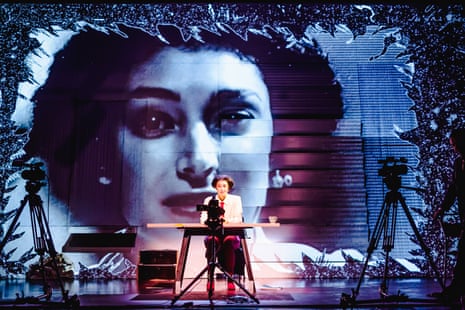New Year’s Eve; a police interrogation room in London’s Soho: a young woman claims to have information about a grisly murder, newly committed. The interview tape is spooling. Her name is Mina Harper, she says, and it was she, not her husband, Jonathan, assisted by Professor Van Helsing, who slew Dracula back in 1895. But this is 1966, and that Mina (Riana Duce) would be in her 90s at least, while this woman is clearly a third that age. WPC Williams (Adela Rajnović) and DS Donaldson (Matt Prendergast) listen with growing incredulity as Mina tells the story that brought her to them.
All three sit around a wooden table. Behind and to either side are screens on to which are projected animated drawings. These illustrate the scenes being played before us and also events from Mina’s past as she relates them. Cameras set on stage capture the actors’ actions (or closeups of their faces) and translate them into line drawings, which become part of this live graphic novel. This multi-platform style makes tremendous demands on actors. Duce, Prendergast and Rajnović meet them with grace and aplomb, creating credible characters while simultaneously setting up technically complex images to be incorporated into the projections (eg Prendergast holds an A4 sheet and a mug in front of his chest; he bends over to present the top of his head to a camera; the image projected on the screen seems to show an overhead shot of him sitting at a table with a coffee and a notepad).
The effect is funny, intriguing, disconcerting. More than this, it is dramaturgically exciting. The production’s ceaseless shifting of perspectives between stage and screen destabilises the viewers’ perception of what is real. Like Mina, we are caught between shadow and solidity. We, like the characters, find ourselves struggling with difficult questions: how to make sense of an existence that has been infected by Dracula; how to respond to evil.
This is a gripping production from theatre company Imitating the Dog, in co-production with Leeds Playhouse, on whose stage, before the pandemic, the company presented its much-lauded, frame-by-frame reconstruction of zombie film classic Night of the Living Dead). Its three artistic co-directors, Pete Brooks, Andrew Quick and Simon Wainwright, magicking together technology and live performance, create spectacular, innovative theatre, as dramatically forceful and thought-provoking as it is entertaining.

Comments (…)
Sign in or create your Guardian account to join the discussion